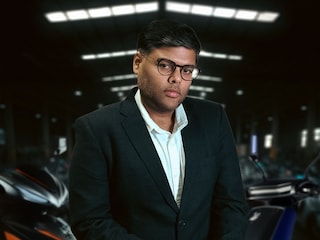The $200-billion opportunity and the brand built to deliver it
E-Went’s customer-first approach is redefining what electric mobility means for India’s most value-conscious riders


In India’s race to electrify its roads, bold claims are easy - execution isn’t. Charging is patchy, build quality uneven, and most customers struggle to separate hype from hardware. E-Went, the electric two-wheeler venture from the Saraogi Group, is doing it differently - by building the one thing India’s EV ecosystem needs most: trust.
“We’re not here to ride the wave,” says Director Umang Saraogi. “We’re here to build something that lasts - for the customer, for the environment, for the future.”
It’s a claim backed by data. Over 15,000 scooters sold. A network of 250+ dealers across seven states. A warranty claim rate under 1.5% over three years. And a product built from scratch to handle not just Indian roads, but Indian realities.
That glimpse into the future sparked the beginning of E-Went. "I looked at it and thought: if it works in China, it can work in India - but it has to be adapted for how India moves.” says Saraogi.
Back home in India, the government had just begun nudging the EV ecosystem forward. The opportunity felt ripe, but Saraogi chose to learn first. “I spent two years just understanding the consumer,” he says. “What they need, what they fear, how they live. EVs had to win on practicality, not ambition.”
That insight led to the founding of E-Went in 2020. The team started with three-wheelers, then quickly pivoted to two-wheelers - where the real opportunity lay. But Saraogi’s biggest takeaway from his early research wasn’t just about the product category. It was about mindset. “If we couldn’t solve for charging, for durability, for long distances and low maintenance - then we weren’t solving anything,” he says.
Problem 1: Range anxiety and no charging infrastructure.
Solution: E-Went developed a dual, portable battery system that can be detached and charged anywhere - at home, at work, even inside a PG. With a real-world range of up to 180 km, it eliminates the need to hunt for charging stations.
“Most of our riders don’t have a parking spot or a socket outside their flat,” says Saraogi. “And if you’re in a shared flat, no one wants to split the electricity bill with you. We designed around that.”
Problem 2: India’s roads and weather conditions.
Solution: Every E-Went scooter is built on a high-grade aluminum-magnesium alloy frame. The motor is IP67 waterproof-rated. The paint resists fading. The compact, reinforced build handles potholes, monsoons, and stop-start traffic with ease.
“We didn’t just test in labs. We tested in Kolkata traffic. That’s how you build for India,” says Saraogi.
Problem 3: Generic tech leads to poor reliability.
Solution: E-Went built its own Maxx Power drivetrain system, with a custom motor, converter, and controller. This in-house stack gives them control over torque, energy efficiency, and ride quality.
“Most brands use off-the-shelf components,” says Saraogi. “That works - until it doesn’t. Our tech is ours, so we can stand behind it.”
Problem 4: Buyers want value, not vague promises.
Solution: E-Went isn’t chasing the cheapest tag. Instead, it’s building value that lasts. Where low-cost imports compromise quality, and legacy brands charge a premium for it, E-Went delivers both. Its scooters are built to last nearly twice as long as entry-level models, yet come in at roughly 40% less than the premium alternatives.
The goal, as Saraogi puts it, is simple: “Make quality accessible, not aspirational.”
That focus meant designing for more demanding users - long commutes, fewer stations, harsher roads. It also pushed them to invest early in service infrastructure: 4 free services per vehicle, a 7-day helpline, and 24-hour parts dispatch.
Ironically, the result is a scooter that outperforms in Tier 1 settings. Quiet, durable, low-maintenance, long-range: it’s a product that satisfies the metro rider, even though it wasn’t designed for them first. “This isn’t about skipping metros,” Saraogi clarifies. “It’s about building a scooter that works for India. All of it.”
But there’s more than manufacturing on his mind. Saraogi is also vocal about the policy challenges EV makers face - from inconsistent state regulations to unclear registration norms. “Right now, the rules vary by state. And that leaves too much room for gray areas and bad actors,” he says. “If we want to build trust in EVs, we need clean, enforceable, national standards.”
And that trust, he believes, is the real battery behind India’s EV future. “Consumers are smart. But they aren’t always informed. It’s our job to show them why something that costs more up front may save them years of frustration.”
The roadblocks aren’t just about infrastructure. Charging stations matter, yes - but so do trust, durability, and service reliability. Consumers aren’t just buying an electric scooter; they’re buying confidence that it will work, every day, in real Indian conditions.
That’s where brands like E-Went change the equation. By solving the India-specific problems - range anxiety, charging access, durability, and after-sales service - and innovating at scale through the Scooter-as-a-Service model for fleets, E-Went is creating not just a greener option, but a viable one for most Indian riders.
Not just the ones who want to be eco-friendly, but the ones who need their vehicle to work, every single day.
And that, perhaps, is where the real revolution begins - not in what India buys next, but in who finally trusts an EV enough to buy it.
The pages slugged ‘Brand Connect’ are equivalent to advertisements and are not written and produced by Forbes India journalists.
First Published: Oct 27, 2025, 12:24
Subscribe Now